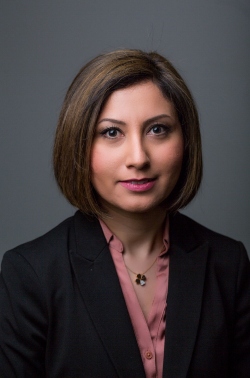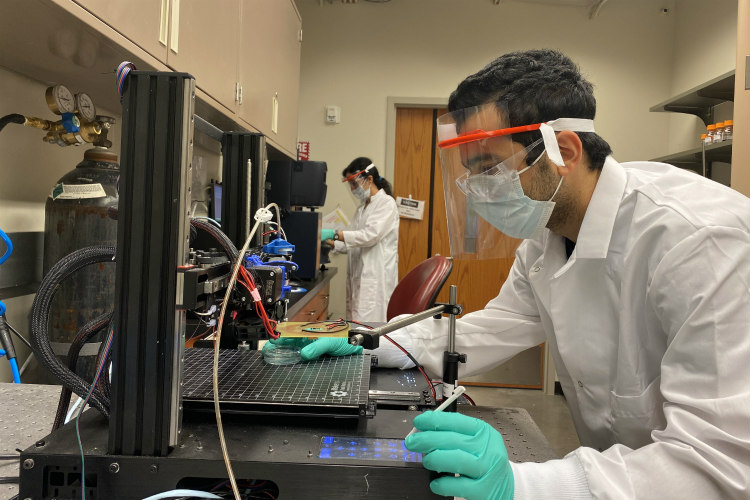As an urban university, UMKC is growing and expanding in many new research areas, which makes it a great place for young faculty to inspire students and launch groundbreaking research careers. Just a few years into her first academic appointment within the School of Computing and Engineering Zahra Niroobakhsh was recently named one of 75 young faculty to receive a Doctoral New Investigator grant from the American Chemical Society in 2020.
Doctoral New Investigator (DNI) grants provide start-up funding for scientists and engineers in the United States who are within the first three years of their first academic appointment at the level of Assistant Professor or the equivalent. The assistant professor, who joined UMKC in 2018, shared details about her research and award.

Why did you choose UMKC to launch your career as a researcher?
I liked the fact that UMKC has a friendly environment, supportive leaders and many potentials for expanding the research given the opening of the new building, Robert W. Plaster Free Enterprise and Research Center, in our school.
What classes do you teach in the School of Computing and Engineering?
I teach Engineering Thermodynamics (ME299) for sophomores and three classes for senior undergraduates and graduate students -- Introduction to Biomaterials, Introduction to Soft Materials and Polymers and Advanced Thermodynamics.
You’re also leading the niROO PRISM Lab, out of which came (student) Mahsa’s Droplets as Continents piece up for auction with Science2Art. Can you tell me more about the lab’s ongoing research studies?
In the niROO PRISM (Printing and Rheology of Interfacial Soft Materials) Lab, the main theme is to use various liquid/liquid-interfacial systems to investigate the structure-property relation of soft interfacial materials.
Currently, one of our focuses is to achieve self-supporting objects by printing liquid into another interactive liquid using our home-built 3D printing system. This work has potential applications related to biological, medical and drug delivery systems. Another focus is using food-grade surfactant systems to remediate oil spill in the ocean in a more sustainable way. That is the research Mahsa’s Science2Art work, which is being auctioned at BioNexus KC, comes from. We’re proud of her.
What got you interested in exploring oil and petroleum?
My research field overlaps with many environmental areas in the oil and petroleum fields due to the presence of similar interfacial phenomena occurring at the interface of the seawater and crude oil. My research has potential impacts on the oil industry and ultimately more sustainable environment.
The DNI grant awards $110,000 over two years for “investigator-initiated, original research.” What are the goals of your proposal?
The proposal aims to develop bijels (bi-continuous interfacially jammed gels) that are sponge shaped, bi-continuous emulsions stabilized by nanoparticles made from the relevant components used in the Enhanced Oil Recovery (EOR). We will tune the bijels stability and rheological properties so that it delays the transition from soft viscoelastic to rigid solid while it enhances the stability of systems in harsh conditions. The proposed research will provide a fundamental understanding of how bijel emulsion can help to improve recovery efficiency and reduce complications during EOR, which is a worldwide concern.
What influenced this project?
While conventional oil recovery techniques are only able to recover about a third of oil from their oilfields, a great amount of original oil in place remains trapped in a discontinuous phase of air, brine and oil. Due to the increasing demand for oil in the market and difficulty to find new giant fields, applying enhanced oil recovery technologies are the most viable and economic way to maximize the recovery efficiency of residual oils.
What have you discovered so far in your research?
Due to new COVID circumstances, the start of the research program is a bit delayed. We’ll start research soon.
Can you describe the achievement of being one of the 75 selected this year?
I feel honored to be the recipient of the Doctoral New Investigators by the American Chemical Society; it's a highly competitive and prestigious award, and it certainly gives me the confidence that my research topic has the potential to be expanded in the next few years. The funding will allow me to expand my research areas in this new direction and expand my research group.
Looking ahead, what do you hope to accomplish in your work – any cutting-edge discoveries, new research methods, major grant awards you’d like to pursue?
I am interested in revisiting the surface sciences that are traditionally applied in detergents and daily care products and using them in new technological advancements like energy storage, and medical and 3D printing applications. I am grateful of the ACS-PRF funds that allow me to obtain preliminary data that could be used for my future career awards.

